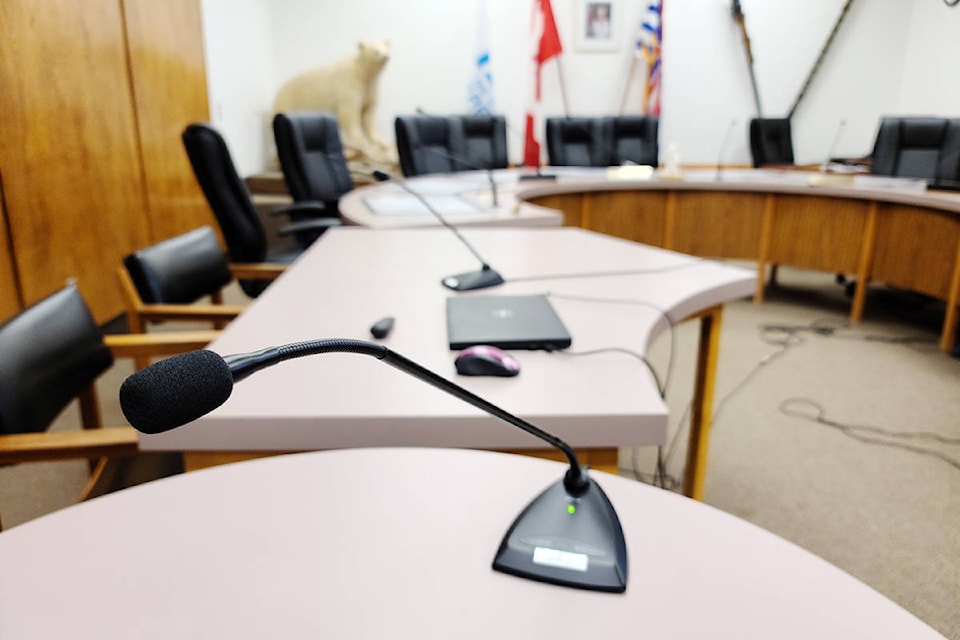The City of Terrace is spending $25,000 to upgrade audio/video technology in council chambers.
Council has relied heavily on streaming and conference calling to conduct its business while maintaining physical distancing since the pandemic began. During regular council meetings, usually only the mayor, two councillors and a handful of other participants such as City staff or media are physically present in council chambers. The remaining councillors participate by audio-only conference calls, as do some delegations and presenters.
Because there is limited room for public attendance in council chambers, the City has taken to livestreaming all of its public meetings.
Currently council chambers are outfitted with a microphone for each seat at the council table and one fixed-view camera that oversees the chambers. The camera has begun to break down and recent livestreams of council meetings have been limited to audio-only.
The proposed upgrades will add new cameras to improve the video feed from council chambers, resulting in superior livestreams of meetings and superior video calls from chambers to outside sources. Additionally, the upgrades will result in the ability to display incoming video feeds on a projector in council chambers, meaning the chambers will be fully capable of video-conferencing. This will allow councillors participating remotely to show video, whereas they are currently limited to audio.
Council is preparing to participate in the Union of B.C. Municipalities Convention (UBCM) — a crucial annual meeting that, among other things, provides an opportunity for municipal politicians to meet with Provincial ministers — which will be held virtually for the first time this year, from Sept. 22 to Sept. 24. Video-conferencing capabilities will allow council richer participation in the conference.
“We would like to get started on this project immediately, with the hope of having conferencing capabilities prior to the UBCM meetings,” said Lori Greenlaw, finance director, to council in a meeting seeking approval for the upgrade project.
The primary components of the upgrade will be two new cameras in council chambers, said Dylan Powell, the City’s information systems manager. The new cameras will be able to pan, tilt and zoom, unlike the current fixed-view camera, and those movements can be automated to focus a camera on whomever is speaking in council chambers. One camera will be aimed toward the table where council sits, and another camera will be mounted behind where council sits, facing toward the area where presenters and delegations sit.
The City will also purchase two video encoder/decoders, which are essentially computers specifically for processing video information. One will be placed in council chambers to quarterback the video feeds from the two new cameras, while the other will be placed in a room downstairs at City Hall that is used as overflow seating for council chambers. Having that encoder/decoder downstairs will allow for a nearly instantaneous video feed from council chambers to the overflow room, whereas currently there is a significant delay, Powell said.
The microphones in council chambers are still good and will not be replaced. However, an audio amplifier — a box which is the central point for audio equipment in the room — will be replaced. Powell said the new amplifier will allow him to optimize the setup of audio equipment in council chambers, possibly reducing feedback, and it will allow him much more flexibility in how he arranges audio equipment within the building.
The cameras, the encoder/decoders, and the audio system currently installed in chambers are all part of an enterprise software and hardware ecosystem called Q-SYS, offered by the company QSC. (A well-known example of a consumer-grade hardware and software ecosytem is offered by Apple Inc. — if you own a Mac computer and an iPhone, they tend to play nicely with one another.)
Powell said it makes sense to have the cameras and encoders/decoders match the existing audio system, and he prefers the Q-SYS ecosystem over competing enterprise ecosystems because it is very flexible and it will allow him to set the system up in such a way that it can be operated easily by less-technically-savvy individuals.
”It gives me the ability to make available to the end-user only what they need to see, so I can do as much as I want in the background, and only expose what really matters to whoever needs to manage the room audio or anything like that,” he said.
Each camera will cost about $4,500, each video encoder/decoder will cost about $2,000, and the audio amplifier will cost about $2,500, Powell said. The remainder of the $25,000 total cost will go toward supplementary items such as cables to connect the equipment.
The equipment is expensive, Powell said, but sticking to the Q-SYS ecosystem will save quite a bit of time and effort.
“[The price] is admittedly very steep, but the amount of administrative overhead is relatively low, which adds value, because that’s time I don’t have to spend working on it,” he said.
Funding for the upgrade will likely come from the City’s Northern Capital and Planning Grant Reserve fund, Greenlaw said, but the City’s grant writer is investigating potential funding sources from higher levels of government.
jake.wray@terracestandard.com
Like us on Facebook and follow us on Twitter
